Understanding Cat Behavior: Turn a Fondness for Felines into Love
By now, it’s redundant to say that cats have taken over the Internet. A quick perusal of social media will always involve stories of our furry friends: here’s a feline sitting on its box throne; there’s another demanding to be served its milk; and here’s another curled up, pushing its human roomie out onto the unsleepable fringes of the bed.
Humans are so fond of cats. We just can’t help it. We might not understand how they put us under their spell, but here’s a chance to understand their behavior better. Read on and turn your fondness for cats into love by better understanding how they communicate.
1. Cat Stare
Cats like to gaze into open spaces as though reflecting on life. They also have a habit of staring at humans, often with unblinking focus. We might wonder if they’re plotting our demise, thinking about taking us down when we’re at our most vulnerable.

Photo by Liliana Marin/ Unsplash
But a cat’s stare might just mean that they want something. They might want to sit on your lap, be fed, or sleep beside you. A soft, blinking gaze may be their way of showing their affection. But beware a prolonged, intense stare. This usually precedes an attack.
2. Hungry for Attention
It’s funny how cats know just when to bother you at the perfect time. When you’re all dressed up and ready to go to work, it’ll follow you everywhere around the house until you finally give in to its demands for a few minutes of cuddling.

Photo by Paul Hanaoka/ Unsplash
There’s no use bargaining. Not giving them what they want only leads to trouble. Your cat might be found licking itself innocently next to broken ornaments or lounging on the table where your mug once sat, or even rolling itself across your keyboard, sending incomprehensible messages and emails out into the world.
3. Anarchist Cats
The great American writer Ernest Hemingway used to have more than fifty cats in his abode in Key West, where he wrote For Whom the Bell Tolls. Most of them were polydactyl cats that he liked to call “the best anarchists”. This might be because cats are highly opinionated creatures, not unlike Hemingway himself.

Photo by Ömürden Cengiz/ Unsplash
Unlike dogs, kitties will only approach humans when they feel like it. Cats are in no way obedient and can very rarely be ordered to do anything. They are capable of love and affection, but it has to be on their terms.
4. Furry Masseuse
It takes more time to earn the trust of a feline than that of a pooch. Those who are patient and brave enough to take a few scratches will eventually win their furry friend over. Some owners, after earning their cat’s hard-earned trust, swear they get massages from time to time.

Photo by Jonas Vincent/ Unsplash
This behavior can be traced back to their time as kittens. When their gentle pinkish paws kneaded their mother’s mammary gland when feeding, they were pressing for more milk. When a cat kneads a human, it means that it’s comfortable with you. It’s an expression of their love, contentment, and pleasure.
5. Why Cats Sniff
Cats are a little bit like dogs in that they like to sniff the place out, especially when they enter new territory. This is their way of figuring out their environment. Being cautious creatures, they are always analyzing places and people, as well as the activities of other animals.

Photo by Jinel Thao Nguyen/ Pixabay
Cats sniff humans to get used to their scent, only if they deem you worthy. It’s their way of bonding, marking you as a familiar. Cats also use their sense of smell to identify food or to determine whether another animal is a friend or foe.
6. Detecting an Eating Disorder
An alleycat in the street is likely to take anything you feed them. With gusto, especially if they are famished or in survival mode. Cats are clever scavengers who will scrounge dumpsters for leftover food to get through the day.

Photo by Perchek Industrie/ Unsplash
But under better circumstances, felines tend to be choosy with their food. They dislike repetitive meals and hate chewing on plastic. If you see a cat eating plastic or non-food materials, it’s likely to have an eating disorder called pica.
7. Warming up to Hunt
Cats are extremely observant. They tend to pick their spots by the window, examining all the minute details of the backyard. Sometimes you’ll forget they’re there because they’re so quiet, like humans in deep study, prepping for an important test.
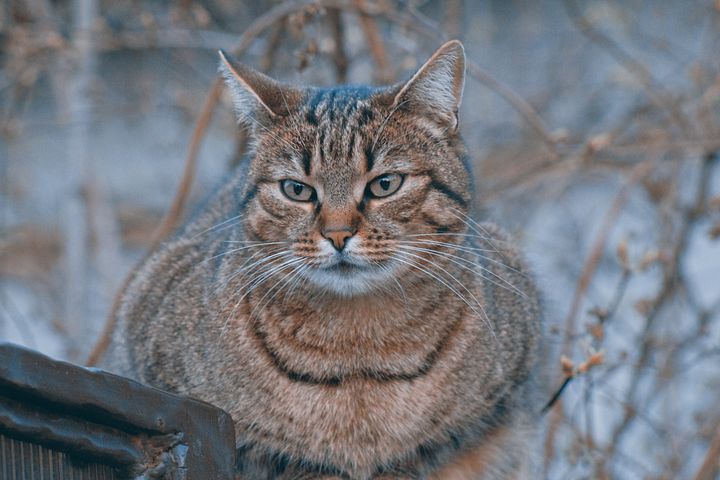
Photo by Caroline/ Unsplash
If they get noisy while eyeing prey, it means they are frustrated, perhaps because of a barrier. If they’re calm while mouthing certain sounds, this might mean they’re warming their muscles up for a kill.
8. Tell Tail Signs
New cat parents might wonder what it means when their feline baby walks towards them with its tail up straight, like a lighthouse scanning the ocean. It could be interpreted by some as an aggressive stance by an angry cat, with its tail up in the air like the blade of a sword, ready to come slicing down.
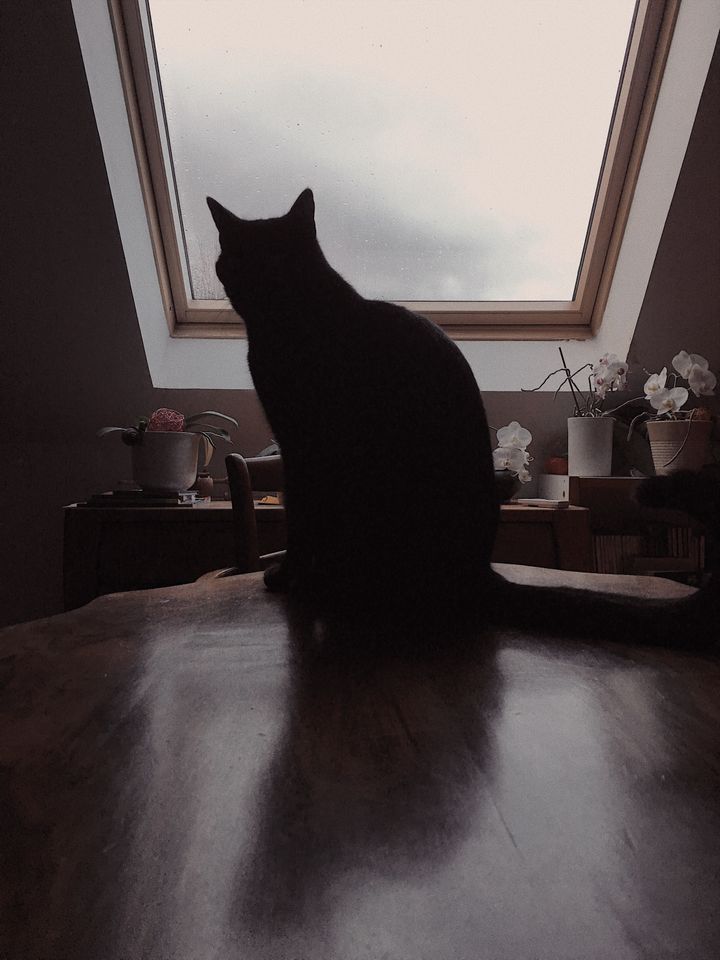
Photo by Camille Frey/ Unsplash
But a straight tail means that your cat trusts you completely. An upright tail is a display of openness. It means that it’s happy to be around you. If your cat turns its back on you, it’s giving you permission to stroke its back.
9. Exposed Belly
It is perfectly normal for domesticated animals to behave defensively, just like their cousins in the wild, especially when they’re out guarding their territory or going further afield. It’s simply in their DNA to be wary of danger.

Photo by athree23/ Pixabay
So when cats roll on the floor and expose their tummies, it’s fairly obvious what they’re saying. They are comfortable and relaxed around you. An exposed tummy is also their way of giving you the green light for a belly rub. It might also mean playtime with a checkered ball or a certain squeaky rubber ducky.
10. Hyperactive After Dark
Cats love to slumber during the day, way beyond how often humans sleep especially on a full stomach. On average, they can sleep from twelve to sixteen hours to the great envy of their hardworking owners, who could only imagine such luxuries in their lives.
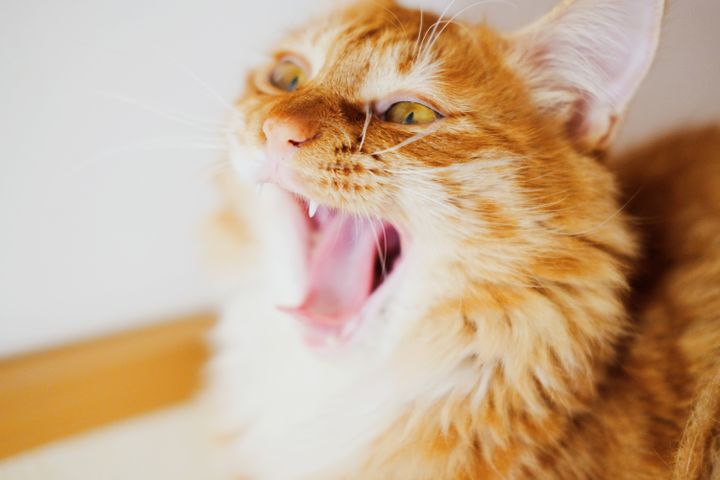
Photo by Alan Chen/ Unsplash
Having slept so much in the day, they wake up with an abundance of energy to spend in the nighttime. If there’s an absence of prey to hunt, cats can become noisy and restless. If they end up breaking things, remember not to take it too personally.
11. Cats Favor Confined Spaces
Domesticated cats never lost the predatory instincts that their bigger and wilder ancestors handed down to them. They are skilled hunters and plan raids even if they are regularly fed at home. As well as being skilled hunters, cats defend themselves pretty well too.

Photo by KiVEN Zhao/ Unsplash
Don’t be too surprised to see your cat nestled in confined spaces. They love the strategic advantage that a cardboard box gives them, just in the same way their wild ancestors would use boulders and caves which shielded their backs from attack.
12. High Energy
Cats are designed to fend for themselves. They’re ready to survive the worst the world can throw at them, and they have a lot of energy stored up for that exact purpose. When cats live in comfort with all the convenience that an owner brings, they end up not knowing what to do with all that energy, like a fully fueled race car with nowhere to go.

Photo by rihaij/ Pixabay
To burn off all that excess energy, cats play games. They go on pretend hunts, chase balls, or go running around the house. There’s nothing wrong with them if they act that way. They’re just energized and bored.
13. Cats Give You Goodies
Most people treat their pets like family. Some even treat pets as if they were their own children. The good news is that cats are capable of loving us back. They can tell when they are being adored or being pampered. Oftentimes, they will try to return the favor.

Photo by Chuan Xu/ Unsplash
To show their gratitude, cats bring their owners gifts: dead mice, bugs, a bouquet of dead plants on the bed. All thoughtful goodies in their eyes, but horrific sights to us. It’s the thought that counts, right?
14. How Cats Behave in a Safe Environment
Cat parents like to share stories about their pets being lazy at home, how they can be seen lying down and getting up only to eat. In between those two endeavors, they might also indulge in a bit of a stretch. If they are found relaxing to the max all day, every day, it means that they have found a place that they can call home.

Photo by Niklas Hamann/ Unsplash
They feel comfortable because they aren’t threatened by a thing. These are signs that they have let their guard down, content with being the king of their castle.
15. Covering Their Tracks
Cats instinctively search for sandy places to defecate so they can also bury their refuse afterward. It’s part of their self-defense, like spies habitually covering their tracks to avoid being caught.

Photo via Imgur
People love them even more for this, as it keeps a home smelling fresh and clean. Finding your cat straying from this instinctive behavior might be a cause for concern. Better consult with a veterinarian if it happens.
16. Pay Attention to Cat’s Ears
Where a cat’s sense of smell falls short compared to that of a dog, it makes up for it with a strong sense of hearing. A cat’s ears have tufts and pockets that enhance its sensitivity to higher and lower sound frequencies. With such powerful ears, a cat can detect even the slightest movements which would have gone unnoticed by a canine.

Photo by Lina Angelov/ Unsplash
You can also tell by their ears if they’re angry. If their ears are cocked backward, it means that they are becoming aggressive. A normal position means it is safe to pet them.
17. Cat Sparring
This pastime isn’t as common as their other favorite forms of entertainment, such as playing games, hopping about on random platforms, or play-hunting. Cats are highly intelligent creatures and see these activities as manifestations of their creativity. People who don’t get this behavior tend to think they are weird.

Photo by Oleg Ivanov/ Unsplash
But it’s not that weird. When they pretend to attack your feet, moving in and out like a hacksaw, they’re simply pretending to hunt, honing their ability without actually intending to harm you. Think of your cat as a prizefighter sparring with its partner.
18. They Love to Sleep
It’s not uncommon for cat owners to come home after a long day of work to find their cats in the same place they were in when they left. Cats sleep for around fifteen hours a day, and may even sleep for longer as they age.

Image by Екатерина Гусева/ Pixabay
There’s nothing wrong with them. When they do this, cats are saving energy so they can hunt at night. Humans think they’re being lazy, but cats call it being energy efficient. This is a trait they inherited from their predatory ancestors, not a sign of laziness.
19. Disturbing Behavior
Cats exhibit all sorts of peculiar behaviors which can be charmingly entertaining to humans. Some of these performances are exclusive to cats, but even if they weren’t, they’d still pull off their antics and create cuteness overloads, on or off the internet.

Photo via Imgur
When cats sulk in a corner, it’s nothing to be alarmed about. But if you see your dear feline bumping its head against the wall, it might be experiencing trauma or suffering from a serious tumor that needs examination right away.
20. Soothing Sounds
The low-frequency hum of a cat’s purr subliminally calms all those within range. It’s an alien sound that soothes our minds and invites us to relax. Cats usually produce a purr when their human caresses or strokes them, as an encouragement to continue.

Photo by Marta Markes/ Unsplash
Cats use purring like a palliative, to relieve stress and to calm their senses. A cat’s purr is like organic medicine. Some researchers say it may heal them if they have minor wounds and can help their bodies promote muscle repair.
21. Trailing Behind Like a Shadow
Cats have a habit of ignoring their master’s call, in contrast to dogs who are consistently eager to please their masters. Cats tend to be snobbish, attending exclusively to their own selfish whims. At other times, however, they might decide to trail you like a shadow.

Photo by anlyu0/ Pixabay
Cats might just feel secure around their beloved humans. But they also like to be in control, thus their curiosity pushes them to seek answers in everything. That might explain why they tend to follow us around, even when we go to the john.
22. Sign of Defensiveness
Other than reading tail signals, it may be hard to tell a cat’s emotions. Unless it hisses and shows obvious signs of distress, cats are easily misunderstood, a mistake which often leads to scratch marks. That’s a cat for you. And that’s partly why humans love them. They are cute but often quite unpredictable.

Photo by christels/ Pixabay
But one way of telling that they are feeling defensive is when their tail is curved downward. It shows they are on the alert and may have sighted prey or danger in the vicinity.
23. Just Let Them Be
As capricious as cats are known to be, humans can’t mistake their hiss for anything else. It’s an obvious sign that a cat is bursting with negative emotion, such as when it is being threatened, angered, or irritated. Needless to say, it’s on the verge of launching into a fight, like a boxer with his back against the ropes.

Photo by Manfred Richter/ Pixabay
There’s no way to calm a cat down when this happens. Just let it be. Don’t try to pet an angry cat or you’ll pay for it with deep scratches all down your arm.
24. Destructive Streak
We’ve all seen them do it on the Internet, and many of us have caught them in the act offline, too. Cats like to push things over the edge like supercilious wise guys, destroying things they feel are worthless, or in their way. It’s not like these are mere accidents.

Photo via Imgur
Cats deliberately close in on their target with razor-sharp focus. They either break things to catch your attention, or they do it to practice their hunting technique. They damage things and slowly walk away like they just don’t care.
25. Scrupulous Pets
Felines are quite finicky, being creatures of royal descent. And they’ve been considered royalty all over the world, from ancient times in the Siamese Kingdom to symbols of monarchy in Great Britain. Even as far back as ancient Egyptian times, they were worshipped as demigods.

Photo by Erda Estremera/ Unsplash
Unlike dogs, they don’t like to make a mess, which is good news for cat owners. Cats like to clean themselves and bury their droppings. They especially appreciate it when a litter box is provided. When it comes to hygiene, dogs have nothing on them.
26. Happy Cats
Cats are generally harder to please than most pets. They are choosy and tend to be aloof and temperamental. But you can make your cat happy by exposing them to catnip, a plant that contains a substance called nepetalactone.

Photo by Fuzz/ Pixabay
This gives joy and happiness to every cat, prompting them to display all sorts of behavior: rolling, rubbing, and meowing; they are as euphoric as can be. Catnip is classified as a kind of mint, and contrary to what you might think, it’s not actually addictive to cats.
27. Cat Grooming: Nail-Biting
Cats are very hygienic creatures and are often seen licking their paws and other body parts while curled up in their corner. It’s kind of their thing, and they do this at any time of the day.

Photo by Canis2016/ Pixabay
They chew on their nails to get rid of the frayed outer layer so a new claw is exposed. But if the nail-biting gets on the extreme side, there’s a possibility that they might be suffering from a parasitic infection. Consult a vet as soon as possible if you notice an overabundance of nail-biting from your feline friend.
28. Hanging Out, Bonding With Cats
Cats have a peculiar way of drawing attention. We love seeing how they behave with elegance and quiet dignity. We are easily rattled when they are disturbed, eager to satiate them.

Photo by Alexandru Zdrobău/ Unsplash
One of the best things about being a cat parent is the assurance that we are loved back and appreciated. It makes our quality time with cats doubly special, knowing that they too cherish our presence and our physical and emotional warmth.
29. Playful Biting
It doesn’t happen often, but it might frighten new owners who may mistake it as an act of aggression. When a house cat tries to bite a stroking hand, most of the time it just means that it’s overexcited. Your kitty may just be having a little too much fun.

Photo by Tania Van den Berghen/ Pixabay
It’s easy to distinguish a playful cat from a defensive or aggressive cat. These playful bites aren’t forceful. It’s the same treatment they give when romping around with other cats: a nibble of affection.
30. Nosing Around
No matter how well-fed or babied they are, certain traits shared by house cats and wildcats alike won’t be repressed. An instinct to hunt is etched into a cat’s DNA. House cats show this by prowling between bedrooms, sneaking around behind wardrobes and under curtains.

Photo by Karsten Paulick/ Pixabay
This is normal cat behavior, as hilarious as it may seem to us. This behavior is as much a part of them as a pattern is on a cat’s fur. For them, it’s playful and fun, and it keeps them active.
31. Munching Grass
If you see a cat chewing on leaves of grass while prowling around the backyard, don’t worry. It isn’t turning into cattle. Cats still love the food that people give them. Grass enriches a cat’s vitamin levels and helps to relieve it of a sore throat.

Photo by birgl/ Pixabay
Grass also helps a cat expel any parasites in its stomach and cures digestive problems. Research also says that cats enjoy the taste and texture of grass.
32. Fear of Water
Most people think that cats are hydrophobic. It’s fairly common to see cats fight with their owners when they wish to bathe them. But if you look closely, you’ll notice that some of them dip their paws in puddles after a rain, or even in swimming pools, as if to examine the water.

Photo by Debbie Lane/ Pixabay
Felines aren’t afraid of getting wet. Most of them just aren’t familiar enough with random bodies of water to take the plunge. If owners get their kitties used to a little wetness when they’re young, bathing them regularly shouldn’t be a problem.
33. A Cat’s Greeting
Stepping inside your house after a long day and hearing a “meow” gives cat owners a certain degree of pleasure. This is a pet’s way of saying “hello” to its master, as humans would say to each other, followed up with a series of short pleasantries.

Photo by Thomas B/ Pixabay
This is the best time to cuddle or stroke a cat’s smooth body to reciprocate the greeting. It would be insensitive to ignore your cat’s greeting by simply passing it by, or turning your back.
34. Distinguishing Cat Vocalization
It would be a mistake to interpret every “meow” as a greeting, or a sign that your feline wants to be cuddled. Don’t we all wish they were more articulate? But if you listen closely, you can tell the difference between one meow and another. Your cat can also be better understood by reading its body language.

Photo by Dimitris Vetsikas/ Pixabay
Some meows are prolonged, which could mean they need something and are likely asking for some food. If a cat chatters while facing a door, this means it probably wants to go somewhere. Be attentive to its tones.
35. Standing on Hind Legs
The sight of a cat standing on its hind legs always tickles our fancy. Seeing this sparks our imagination. How close they are to becoming the furry human baby we often imagine them to be! The sight always makes us happy and giggle.

Photo by rick-t-t/ Unsplash
But this is their way of appearing larger than they are to scare potential predators away. This cute stance is a defensive tactic they employ when threatened.
36. The Urge to Scratch
Pet owners might find it strange when cats start scratching the furniture or go at the carpet with their sharp claws. This doesn’t mean they are being stubborn, defying house rules, or being antagonistic. Scratching is simply one of their primal urges.

Photo by rihaij/ Pixabay
The act shows that they are marking their territory. A scent is left everywhere they choose to scratch by the scent glands located in their paws. This may also be their way of exercising, sharpening their nails, or relieving themselves of anxiety.
37. Cat Flexing and Stretching
The sight of a cat flexing its muscles and elongating its body, especially when it wakes up, is indicative of the good relationship your cat has with you. It feels comfortable and trusts you enough to perform a quick yoga session, reaching forward with its back extended.
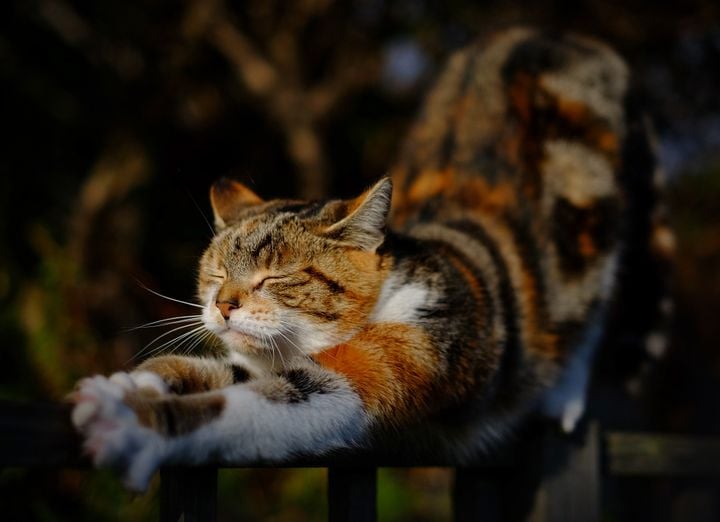
Photo by Zoltan Tasi/ Unsplash
Cats do this to control their blood pressure, and also to warm up after being dormant for some time. They can double or triple their length this way, reaching out with their paws and assuming odd positions, to our delight.
38. Balancing Feature
Curiosity will lead cats to explore the darkest recesses of our houses. They enjoy climbing up onto the roof and searching for prey there. That’s typically how they often end up having weird accidents, like falling off trees where they might have been stalking birds.

Photo by squibkey/ Pixabay
But when cats do fall, they often land safely on their feet, thanks to a special balancing feature called a righting reflex. They flip over like an ice skater or a stuntman performing a practiced landing, even if they had begun the fall on their back.
39. A Friendly Head-butt
This behavior is not the same as a mountain goat trying to gore you with its horns. Cats do it gently with a bump so soft that it might also be a gentle rub. They do it when they feel close to a human or another animal. It’s their way of showing that you’re part of their trusted circle of friends.
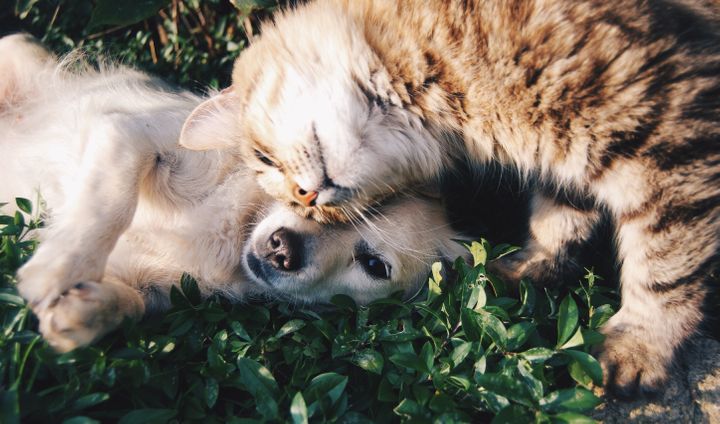
Photo by Krista Mangulsone/ Unsplash
A scent gland below their ears releases pheromones. Felines share their pheromone scent with objects of affection by rubbing their heads and bumping. This is as good a declaration of love as anything else.
40. Cat Naps
Sometimes cats prefer curling up on the floor in a corner rather than sleeping on the laced, expensive, comfortable cribs their owners buy for them at fancy pet shops. They also prefer being walled in, like soldiers hiding behind the ramparts.

Photo by Dimitris Vetsikas/ Pixabay
It’s in their nature to snuggle in places where they feel safe, knowing that their backs aren’t exposed to potential threats. Curled up, they can take a defensive position and feel warm. It is best to just let them be when they are in this state.
